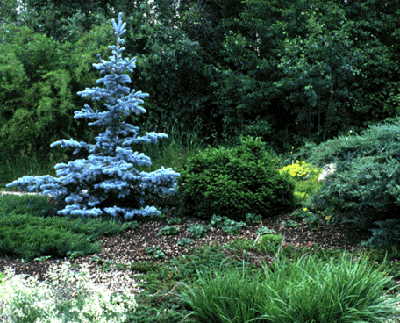Picea pungens
Colorado spruce

Plant form |
Evergreen, coniferous, conical tree. |
Size |
60-100 feet tall and 15-25 feet wide. Dwarf and weeping cultivars are available. |
Needles |
Green to blue narrow needles, about 3/4 to 1 inch long, stiff and densely crowded on the stem. Some may have a white coating. Attractive all year, but whitish-blue color can be rubbed off by snow, ice, or fingers. |
Cones |
The papery cones are 3 to 4 inches long and yellowish in color.They are usually high in the tree. |
Native area |
Southwestern United States. |
Water use |
Moderately low. |
Light |
Full sun. |
Culture and Maintenance |
Grows well in a wide range of soil types. No special maintenance required in the Inland Pacific Northwest. Colorado spruce trees may get Cooley spruce gall aphid, but they are not as susceptible to it as other spruces are. This insect causes the branch tips to swell and die, and these galls may be mistaken for small cones. Another insect, the spruce aphid, may be a problem in warmer areas. |
Hardiness |
USDA Zone 2. |
Other |
Provides excellent shelter for small birds. |
Cultivars |
Named cultivars are typically selected for bluer color or special forms; these will be sold as grafted plants. Unnamed trees are typically started from seeds, so these will be variable in color and form. |
Life is good at WSU.
Secondary content can be almost anything. If you are not using this region delete all the content that is in between the div tags with the id ="additional".
A unique richness of students, faculty, location, activities, and organizations creates a full, lively student life at the University. This section gives you the insider's view on student life and a sampling of the opportunities here.
"Glimpses." Students talk about life at WSU
These brief posts are written by WSU students to give you a personal look through their window on campus life.